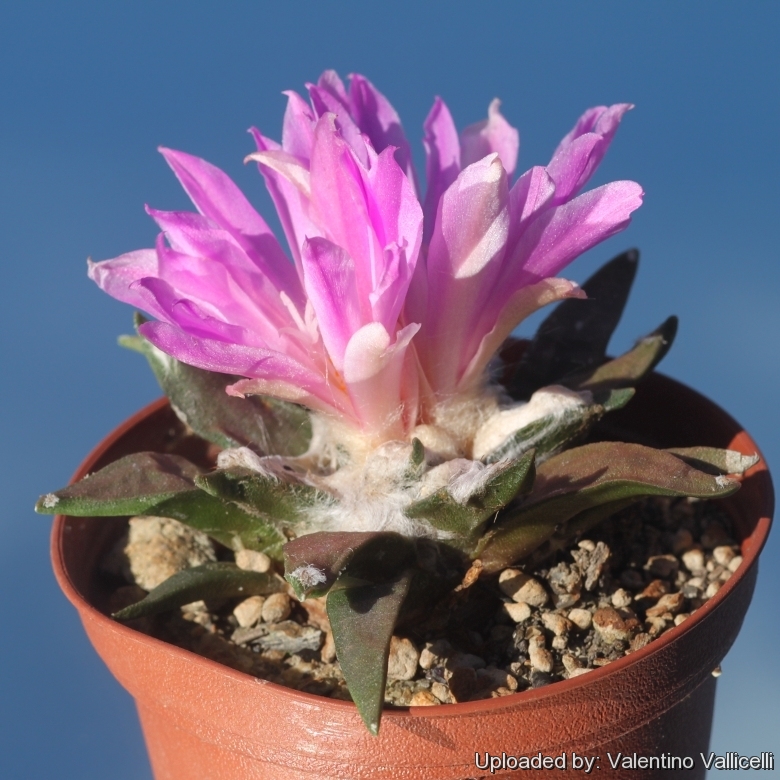
Ariocarpus hybrid agavoides x elongatus Photo by: Valentino Vallicelli
Origin and Habitat: Garden origin (Nursery produced hybrid).
Synonyms:
Description: It is a small slow growing solitary cactus obtained by crossing ♀ Ariocarpus agavoidesSN|847]]SN|847]] x ♂ Ariocarpus retususSN|847]]SN|2079]] var. elongatus. The superb features of this rare plant are due to the intersection between the traits of the ancestors. It has inherited by Ariocarpus agavoidesSN|2079]]SN|847]] the thin, acute tubercles wich presents a wider flattened upper surface like in Ariocarpus retususSN|847]]SN|2079]] var. elongatus. The flower are also very beautiful and reminds those of the Ariocarpus agavoidesSN|2079]]SN|847]]. It is however quite variable due to its hybrid origin.
Habit: Small rosette shaped succulent with stiff, rough tubercles.
Stem: Greenish-brown, greyish-green, yellowish-green or dark green sub-globose, flattened on top, 5-8 cm high, rising barely above ground level, 7-12 (or more) cm in diameter. The rest of the plant (swollen rootstock) stay underground.
Tubercles: Divergent, often flaccid and not erect, thin (buts somewhat wider than in Ariocarpus agavoidesSN|847]]SN|847]]) acute at the apexes, flattened adaxially, slightly fissured, not incurved, 3-7 cm long, 5-15 mm broad, usually more than 4 times as long as wide.
Areoles: Apical or sub-apical, rounded, 1-5 mm in diameter.
Spines: None.
Flowers: Up to 5 cm in diameter, up to 5 cm long pinkish to magenta.
Fruits: Not known.
Subspecies, varieties, forms and cultivars of plants belonging to the Ariocarpus hybrid group
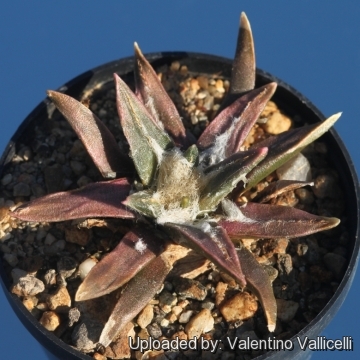 Ariocarpus hybrid agavoides x elongatus Photo by: Valentino Vallicelli
Ariocarpus hybrid agavoides x elongatus Photo by: Valentino Vallicelli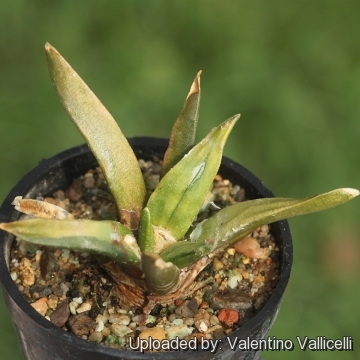 Ariocarpus hybrid agavoides x elongatus Photo by: Valentino Vallicelli
Ariocarpus hybrid agavoides x elongatus Photo by: Valentino Vallicelli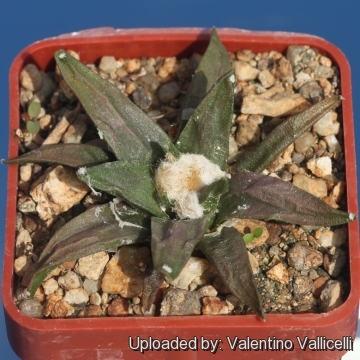 Ariocarpus hybrid agavoides x elongatus Photo by: Valentino Vallicelli
Ariocarpus hybrid agavoides x elongatus Photo by: Valentino Vallicelli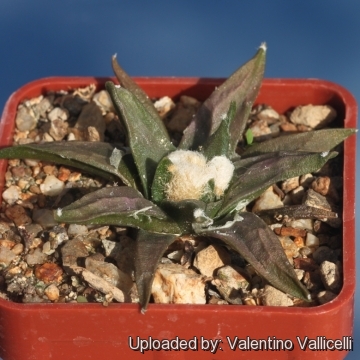 Ariocarpus hybrid agavoides x elongatus Photo by: Valentino Vallicelli
Ariocarpus hybrid agavoides x elongatus Photo by: Valentino VallicelliCultivation and Propagation: It’s a relatively easy species to cultivate, but very slow growing. Needs a very well drained soil. Requires strong sun to part sun to develop good spinal growth and waterings should be rather infrequent, to keep the plant compact and not become excessively elongated and unnatural in appearance. Keep dry in winter, or when night temperatures remain below 10° C (but some people give this plant a light monthly watering to prevent the drying and shedding of the lower tubercles.) it is hardy to -4°C for a short period. Assure a good ventilation.
Propagation: It can be reproduced by seeds. Young seedlings are tiny and they need several years to reach adult size, and require very careful watering. Many growers graft tiny 2-3 month seedlings and they grow on very successfully that way.















